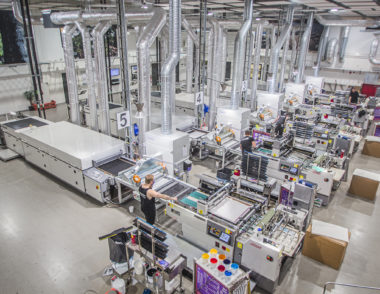About this article
Categories
It’s hardly a secret that a lot has happened in the world of computing in a very short space of time. A lot of new file formats have been released and since each format has its own pros and cons, it can be hard to navigate your way around this jungle. So we’re going to take a closer look at some of the most common and easiest to use formats.
We at Hot Screen always need a vectorised file in AI, EPS or PDF format to be able to print your logo. These are the only formats we can use to create your print.
When Adobe launched the PDF format in 1993, few would have imagined that it would have had such an enormous impact as it has in fact had. What makes this format stand out is that it offers a standardised display regardless of software, hardware or operating system. The ambition was to launch a format that was both scalable and usable regardless of your system specs. When we send corrections out to customers like you, the files will always arrive in PDF format.
This is one of Adobe’s own formats and is distinguished by its use of vectors. This means the format has almost no fixed size and can be scaled according to individual needs. As a result, it has become enormously popular when it comes to publications. Since the file is based on lines, rather than pixels, it’s easier for software to mathematically scale images to the required size.
When working out of Adobe Illustrator, another of our favourite file types is EPS. This is a file format that is used above all in vector graphics, but it can also be used for raster graphics. What makes this file format stand out from the ordinary PostScript is the fact that with an EPS file, the quality of the file has to be left in the exact same state and with the exact same colours as it was created in.
PostScript is a programming language designed to be used to describe how pages should look when printed, on a screen or in a printer.
Just like the PDF, Adobe launched PSD as a sort of universal document with all the relevant information. However, this format was largely intended to be used together with their own Photoshop software. And although in recent years a large number of programs have been made capable of displaying PSD files, it is mostly Adobe’s own program that supports all its functions. PSD can be used to help separate an image into different layers and to document all changes. A usable format that unfortunately mostly requires you to have Photoshop.
This file format is one of the most common and is something of a standard these days when it comes to compressed and easy-to-manage images. JPG is often used when it comes to publishing images online, but it has also become common practice in the context of other publications. This format is characterised by the fact that it compresses the images, which reduces the quality but saves on space. The ability to achieve relatively small image files is exactly what has made JPG one of the most popular formats of all. Alongside PNG, it is probably the most standardised image format available.
Alongside JPG, PNG is probably one of the internet’s most well-used file formats. What distinguishes PNG is that it can handle a large number of colours and can present graphics in very high resolution.
This file format has had something of a boom in recent years. This is down to the fact that it allows you to make simple animations with a relatively high degree of compression which offers a very small file size. A GIF often contains short video loops.
This relatively modern file format has become an informal standard when it comes to vector graphics. A major benefit of the format is that it can handle any resolution. This makes it a popular format both online and when it comes to publication. Thank to a scalable structure and easy-to-manage files, it is one of the most popular formats of all.
About this article
Written by:
Max Schelin
Categories
Related articles

Design your own print
Read more

PMS Colors at Hot Screen
Read more

Configure your file for printing!
Read more
Vector files are most commonly saved in EPS, AI or PDF format.
About this article
Written by:
Max Schelin
Categories
Related articles

Design your own print
Read more

PMS Colors at Hot Screen
Read more

Configure your file for printing!
Read more

Prints on workwear? Choose the heat transfer Stark!
Products
Tips & Tricks

The plotter print is a variation of our product Stark Heat Transfer.
Products

Learn more about the various print methods in the textile industry.
Print methods
Mon-Thu: 08.00-16.30
Fri: 08.00-15.30
Följ oss!
When you archive an article, it disappears from your webshop and is no longer orderable.
When you activate an article, it disappears from your archive and you can order it again